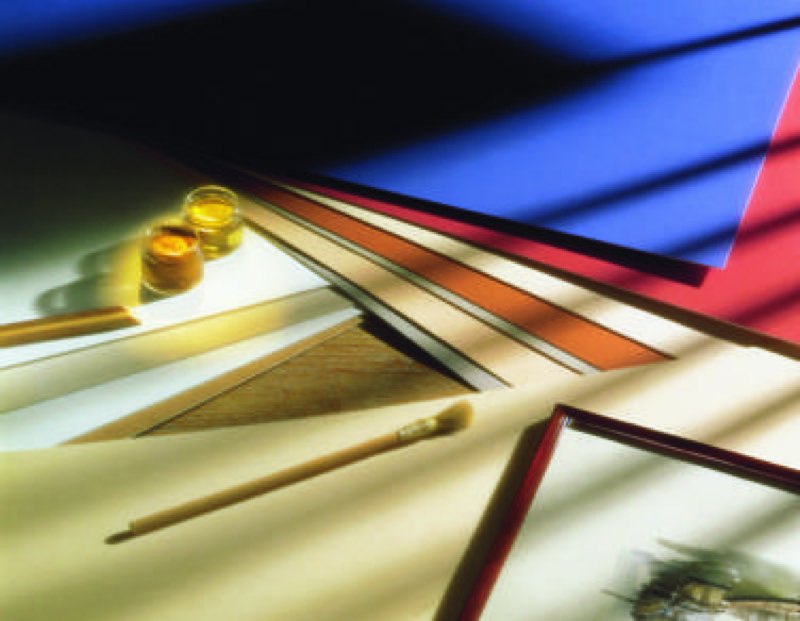Emphasize the artwork
Far from highlighting the subject, a frame and mat which are too sophisticated will overpower a subtle work. There are so many possibilities for customizing your frame: multiple bevels, mat liners, filigree lines and washes; but a clean and simple frame and mat is often preferable.
Carefully select the colors that you plan on using, especially for the mat. No rule requires that you prefer harmony over contrast, so try out different colors. You can try out ideas by putting test strips of different colors of paper around the artwork.
Things to consider:
- Dark shades emphasize the contrasts in a work, but make it appear darker,
- Bright colors flatter bold art with a strong character.
- The delicate refinement of watercolors and engravings can be best revealed when matted in a neutral color such as off white.
Note: Which kind of framing should you use?
-Engravings, lithographs and watercolors: delicate washes.
-Watercolors or dry media (charcoal, graphite etc.) should never come into contact with the glass: use of a bevel, a mat board or a linerboard is recommended.
-The classic English bevel can be used for almost all framing situations. French bevels are traditionally only used for engravings. Straight bevels are suitable for contemporary pieces and artwork which is characterized by simple lines.
-Canvases and tapestries are stretched onto a frame, without glass…
-Powdery media (pastels, charcoal or sanguine chalk) create particles: a block placed under the bevel will discreetly collect them, without spoiling the rest of your framing.
Choosing a frame
Plain or elaborately carved, its only purpose is to highlight the artwork. As a general rule, with a neutral mat you may use more color in your moldings, echoing, for instance, the dominant color of the work.
-A reproduction: Choose a frame in a style suitable (for the time period and origin of the work).
-An oil painting: choose wood, always restrained, or even gilt (both accentuate the luminosity of the work).
Take the necessary precautions
Covering a mat, for example, requires placing the materials used on your work surface. Make sure that the work surface is always clean.
Reserve an area specifically for using glue.
Put your work in a press (under cardboard and a few weights: telephone directories, encyclopedias…). Don't ever skip this step and be sure to observe the minimum drying times.
Turn to wet techniques on water-resistant papers. Dry your washes and filigree lines flat, far away from the rest of your work and supplies.
Use the glazing technique to glue all fragile materials. When in doubt, it's better to take this precaution instead of having to repair a catastrophe…
Clean the glass on both sides before making the package!
Tip: Which way should you lay the paper?
Most papers stretch more in one direction than in the other when conditions are humid. You should take this into account when using glue and adhesives: cut your strips of paper perpendicular to the fibers. This will help counter this tendency.
Think ahead
The art of framing requires you to anticipate the consequences of each one of your actions, and to comprehend the final results!
Consider the shape of the mat opening: round, and you will have to use a square frame… not to mention a few regrets when it's time to attempt to cut the very tricky circular beveled edge!
Double check your measurements. Start by cutting out the longer pieces. If you make a mistake, you can perhaps "recycle" your mistake for use on the shorter sides.
Be sure you have all the materials needed to cover your mats.
Balance out inverse bevels (raised) with elements which create an equal depth (mat liners and/or bevels). If necessary, make a sample first.
Caring for your artwork
Do not use direct application (glue applied directly onto the backing) for antique and fragile documents: the process is irreversible and will reduce the value of the artwork. For the same reason also, never cut margins.
Make small openings in the corners of the packages of old artwork to allow it to breathe.
Your artwork should only ever be exposed to open air on three occasions: during the initial trial period for colors and materials, while measuring the mat opening, and when it is being affixed to the mounting board. At all other times… protect it well!



